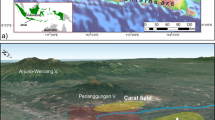Abstract
The limited data available on the mechanism and the efficiency of the processes by which petroleum is expelled in the subsurface from source rocks into adjacent reservoir rocks are mostly qualitative1,2. We present here material balance-type comparisons of sample series extending from the centre portions of two adjacent hydrocarbon source rock units towards their outer edges3, which enable expulsion efficiencies to be determined. In certain parts of the shale the expulsion efficiencies for total extract and its saturated and aromatic hydrocarbon fractions, have much higher values than previously thought (reaching up to 80% for the total extract) which increase towards possible secondary migration avenues. The expulsion is associated with fractionation effects, such as those based on polarity differences. Also, expulsion efficiencies were found to be related to the degree of hydrocarbon saturation of the pore system: they are higher for a rich, oil-prone source rock unit compared with a poorer quality one, which had generated less hydrocarbons.
This is a preview of subscription content, access via your institution
Access options
Subscribe to this journal
Receive 51 print issues and online access
$199.00 per year
only $3.90 per issue
Buy this article
- Purchase on Springer Link
- Instant access to full article PDF
Prices may be subject to local taxes which are calculated during checkout
Similar content being viewed by others
References
Tissot, B. P. & Welte, D. H. Petroleum Formation and Occurrence (Springer, Berlin, 1978).
Hunt, J. M. Petroleum Geochemistry and Geology (Freeman, San Francisco, 1979).
Vandenbroucke, M. in Advances in Organic Geochemistry 1971 (eds Gärtner, H. R. & Wehner, H.) (Pergamon, Oxford, 1972).
Radke, M., Sittardt, H. G. & Welte, D. H. Analyt. Chem. 50, 663–665 (1978).
Radke, M., Willsch, H. & Welte, D. H. Analyt. Chem. 52, 407–411 (1980).
Leythaeuser, D. & Schaefer, R. G. in Advances in Organic Geochemistry 1983 (eds Schenck, P. A., de Leeuw, J. W. & Lijmbach, G. W. M.) (Pergamon, Oxford, in the press).
Espitalié, J. et al. Rev. Inst. Fr. Petrol. 32, 23–42 (1977).
Tissot, B. P. et al. Bull. Am. Ass. petrol. Geol. 58, 499–506 (1974).
Rabitz, A. Fortschr. Geol. Rheinld. Westf. 13, 125–194 (1966).
Mackenzie, A. S. et al. Nature 301, 506–509 (1983).
Leythaeuser, D. et al. Bull. Am. Ass. petrol. Geol. 68, 196–219 (1984).
Altebäumer, A. M. thesis, Univ. Aachen (1983).
Craft, B. C. & Hawkins, M. F. Applied Petroleum Reservoir Engineering (Prentice-Hall, Englewood Cliffs, 1959).
Durand, B. et al. Proc. 11th World Petroleum Congr. 1, 1–13 (1983).
Connan, J. & Cassou, A. M. Geochim. cosmochim. Acta 44, 1–23 (1980).
Brooks, J. D., Gould, K. & Smith, J. W. Nature 222, 257–259 (1969).
Lijmbach, G. W. M. Proc. 9th World Petroleum Congr. 2, 357–369 (1975).
Didyk, B. M. et al. Nature 272, 216–222 (1978).
Author information
Authors and Affiliations
Rights and permissions
About this article
Cite this article
Leythaeuser, D., Radke, M. & Schaefer, R. Efficiency of petroleum expulsion from shale source rocks. Nature 311, 745–748 (1984). https://doi.org/10.1038/311745a0
Received:
Accepted:
Issue Date:
DOI: https://doi.org/10.1038/311745a0
This article is cited by
Comments
By submitting a comment you agree to abide by our Terms and Community Guidelines. If you find something abusive or that does not comply with our terms or guidelines please flag it as inappropriate.



